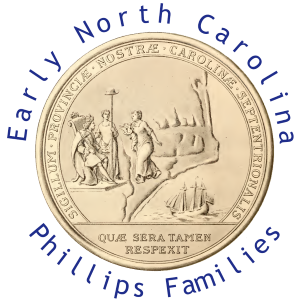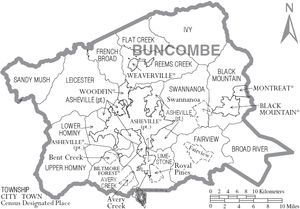Buncombe County, North Carolina
From ENC Phillips Group Wiki
| Buncombe County | |

| |
| Founded 1791 | |
| Website www.buncombecounty.org | |
Buncombe County is a county located in the U.S. state of North Carolina. It is part of the Asheville, North Carolina, Metropolitan Statistical Area. The population estimate for 2008 was 229,047.[1] Its county seat is Asheville.Template:GR
Contents
History
The county was formed in 1791 from parts of Burke County and Rutherford County. It was named for Edward Buncombe, a colonel in the American Revolutionary War, who was captured at the Battle of Germantown.
In 1808 the western part of Buncombe County became Haywood County. In 1833 parts of Burke County and Buncombe County were combined to form Yancey County, and in 1838 the southern part of what was left of Buncombe County became Henderson County. In 1851 parts of Buncombe County and Yancey County were combined to form Madison County. Finally, in 1925 the Broad River township of McDowell County was transferred to Buncombe County.
In 1820, a U.S. Congressman, whose district included Buncombe County, unintentionally contributed a word to the English language. In the Sixteenth Congress, after lengthy debate on the Missouri Compromise, members of the House called for an immediate vote on that important question. Instead, Felix Walker rose to address his colleagues, insisting that his constituents expected him to make a speech "for Buncombe." It was later remarked that Walker's untimely and irrelevant oration was not just for Buncombeit "was Buncombe." Thus, buncombe, afterwards spelled bunkum and then shortened to bunk, became a term for empty, nonsensical talk.[2]
Law and government
Buncombe County is a member of the Land-of-Sky Regional Council of governments.
Buncombe County has a council/manager form of government.
The 2008 election voted in the current commissioners: K. Ray Bailey, Holly Jones, Bill Stanley, Carol Peterson, and chair David Gantt. The county manager is Wanda Greene.
Geography
According to the U.S. Census Bureau, the county has a total area of 660 square miles (1,709 km²), of which, 656 square miles (1,699 km²) of it is land and 4 square miles (10 km²) of it (0.58%) is water.
The French Broad River enters the county at its border with Henderson County to the south and flows north into Madison County. The source of the Swannanoa River, which joins the French Broad River in Asheville, is in northeast Buncombe County near Mount Mitchell. A milestone was achieved in 2003 when Interstate 26 was extended from Mars Hill (north of Asheville) to Johnson City, Tennessee, completing a 20-year, half-billion dollar construction project through the Blue Ridge Mountains.
Major highways
National protected areas
TownshipsThe county is divided into sixteen townships: Asheville, Avery Creek, Black Mountain, Broad River, Fairview, Flat Creek, French Broad, Ivy, Leicester, Limestone, Lower Hominy, Reems Creek, Sandy Mush, Swannanoa, Woodfin, and Upper Hominy. Adjacent counties
DemographicsAs of the censusTemplate:GR of 2000, there were 206,330 people, 85,776 households, and 55,668 families residing in the county. The population density was 314 people per square mile (121/km²). There were 93,973 housing units at an average density of 143 per square mile (55/km²). The racial makeup of the county was 89.06% White, 7.48% Black or African American, 0.39% Native American, 0.66% Asian, 0.04% Pacific Islander, 1.15% from other races, and 1.23% from two or more races. 2.78% of the population were Hispanic or Latino of any race. There were 85,776 households out of which 27.50% had children under the age of 18 living with them, 50.50% were married couples living together, 10.80% had a female householder with no husband present, and 35.10% were non-families. 28.90% of all households were made up of individuals and 10.60% had someone living alone who was 65 years of age or older. The average household size was 2.33 and the average family size was 2.86. In the county the population was spread out with 21.90% under the age of 18, 8.60% from 18 to 24, 29.30% from 25 to 44, 24.80% from 45 to 64, and 15.40% who were 65 years of age or older. The median age was 39 years. For every 100 females there were 92.30 males. For every 100 females age 18 and over, there were 88.90 males. The median income for a household in the county was $36,666, and the median income for a family was $45,011. Males had a median income of $30,705 versus $23,870 for females. The per capita income for the county was $20,384. About 7.80% of families and 11.40% of the population were below the poverty line, including 15.30% of those under age 18 and 9.80% of those age 65 or over. CommunitiesCities and townsCensus-designated placesOther placeSee alsoReferences
External links
| |||||||||||||||


